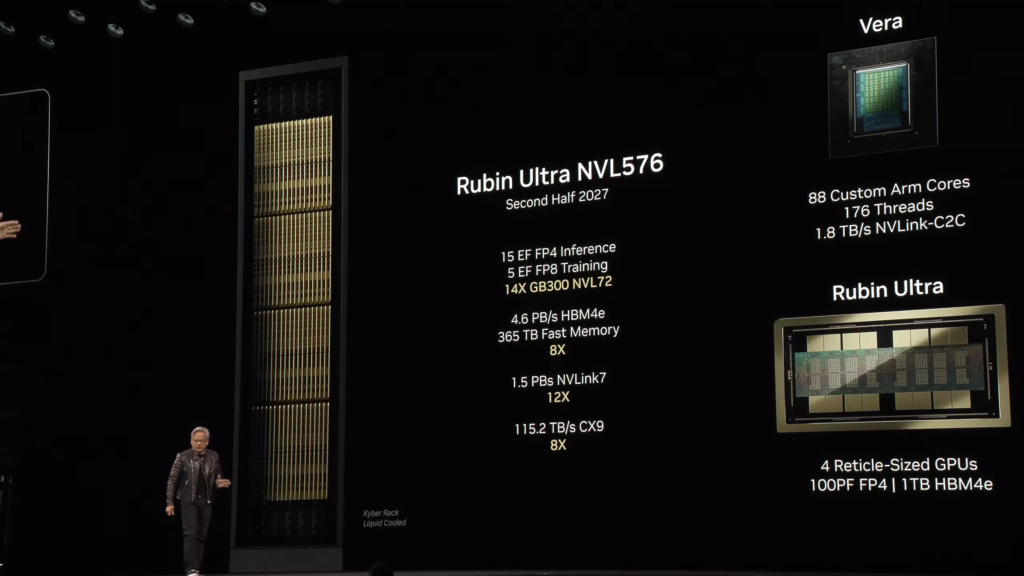
At the 2025 GTC conference, NVIDIA introduced two groundbreaking AI chips—Blackwell Ultra and Vera Rubin—that promise to redefine the capabilities of artificial intelligence hardware. These new chips highlight NVIDIA’s continued leadership in high-performance computing, aimed at powering the next wave of AI applications in industries ranging from healthcare and autonomous vehicles to scientific research and robotics.
The Blackwell Ultra Chip: Unprecedented Performance for Today’s AI Demands
Set to launch later this year, the Blackwell Ultra chip represents a major leap forward in AI processing power. Building upon the architectural foundation laid by its predecessors, Blackwell Ultra is engineered to deliver dramatically higher throughput, efficiency, and scalability.
One of the key innovations in Blackwell Ultra is its advanced memory hierarchy, designed to handle increasingly large and complex AI models. As the size of datasets and neural networks continues to grow, memory bandwidth and latency have become critical bottlenecks. NVIDIA’s new chip incorporates state-of-the-art memory interfaces that allow for faster data retrieval and more efficient data movement within the processor. This results in improved training times and reduced inference latency, directly translating to better performance for machine learning workflows.
Another significant feature is its expanded tensor core capacity. Tensor cores, specialized processing units optimized for matrix operations, are at the heart of NVIDIA’s approach to AI acceleration. The Blackwell Ultra’s updated tensor cores introduce support for additional data formats and higher precision calculations, making it more versatile for a range of AI tasks. Whether it’s running advanced natural language processing models, performing real-time image recognition, or simulating complex physics environments, Blackwell Ultra provides the computational horsepower required for cutting-edge applications.
Vera Rubin: The Platform for Future AI Frontiers
While Blackwell Ultra addresses immediate performance needs, the Vera Rubin platform is NVIDIA’s vision for the next decade of AI computing. Expected to debut in late 2026, Vera Rubin is not just a single chip—it’s an entire AI superchip platform. By combining multiple processing units on a single package, Vera Rubin will deliver unprecedented levels of parallelism, efficiency, and flexibility.
Named after the pioneering astronomer Vera Rubin, whose work revolutionized our understanding of dark matter, this new platform seeks to push the boundaries of what’s possible in AI research. Vera Rubin is designed to support massively scaled AI models that were previously impractical to run. For example, next-generation language models that require trillions of parameters can be trained and fine-tuned more efficiently, thanks to the platform’s integrated high-bandwidth interconnects and advanced cooling solutions.
In addition to raw processing power, Vera Rubin is optimized for energy efficiency—a critical factor as AI systems scale. With its emphasis on sustainable AI computing, the platform incorporates dynamic power management features and cutting-edge cooling technologies that significantly reduce energy consumption compared to traditional architectures. This makes Vera Rubin an ideal choice for data centers, supercomputing facilities, and enterprises that are looking to expand their AI capabilities while keeping environmental impact in check.
Applications and Impact Across Industries
The introduction of Blackwell Ultra and Vera Rubin is set to have far-reaching implications. In healthcare, for instance, these chips will enable more accurate diagnostics by accelerating the training of complex medical imaging models. Autonomous vehicles will benefit from faster real-time data processing, enhancing safety and reliability. In scientific research, Vera Rubin’s ability to handle massive workloads will drive new discoveries, from climate modeling to drug discovery.
Moreover, NVIDIA’s advancements will further solidify AI as a cornerstone of modern computing. By offering both immediate performance improvements with Blackwell Ultra and long-term scalability with Vera Rubin, NVIDIA is addressing the diverse needs of developers, researchers, and enterprises. This dual-pronged approach ensures that the company’s technology remains relevant and impactful as AI continues to evolve.
A New Era of AI Hardware
NVIDIA’s unveiling of Blackwell Ultra and Vera Rubin is more than just a product launch—it’s a declaration of where AI hardware is heading. These chips embody a future in which AI systems are faster, more efficient, and capable of solving previously intractable problems. As the world increasingly relies on AI to address complex challenges, NVIDIA’s innovations will play a pivotal role in shaping the solutions of tomorrow.
